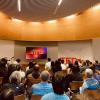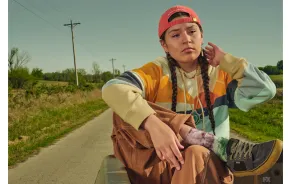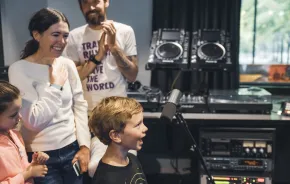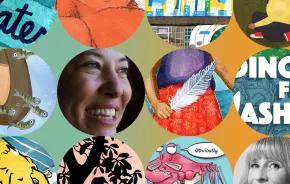
Photo:
Art from John Muir Elementary Photo credit: Julie Trout
A friend of mine recently attended her daughter’s school choir performance. It wasn’t what she expected.
“My reaction: disbelief and outrage as [the students, all white] started bee-bopping on a shoe box talking about folk music down South,” she told me. “Did [the teacher in charge of the production] understand the struggle of poor black people and where that music came from?”
It sure didn’t seem like it, she says. “I’m a single black mother. If [the teacher] cared so deeply about our culture, why not teach ‘Lift Every Voice and Sing’ [editor’s note: This song is often referred to as the ‘Black American National Anthem’].”
The final straw? “I gave into my despair when they started singing ‘Hawaiian Roller Coaster Ride.’ Clearly no culture was safe.”
Understanding appropriation and art
Many of us grew up learning about multiculturalism. Adults encouraged us to sample the creative output of a variety of cultures through songs, clothes and food. Now grown-ups ourselves, we often think doing so is the best strategy for our own kids. Reconsider that, says LeiLani Nishime, associate professor of communications at the University of Washington.
Such an approach “celebrates culture without acknowledging the history of oppression,” says Nishime, author of Undercover Asian: Multiracial Asian Americans in Visual Culture. Celebrating a tradition without the context of the tradition’s culture of origin can become self-congratulatory, she explains; participants can feel virtuous without much effort. “It makes it easier not to address underlying inequalities,” says Nishime.
There’s a term for this kind of behavior: cultural appropriation, or when one culture takes elements from another without consent or acknowledgement. You may have heard the term used in reference to mainstream news such as the Boston Museum of Fine Arts “Kimono Wednesday” or festival-goers’ clothing choices. More locally, you might have seen Seattle Opera’s education events surrounding issues of appropriation in “Madame Butterfly.”
“When you talk about cultural appropriation you also have to talk about context,” says Nishime. Who has the power in this situation? What’s the history here?
Asking these questions is particularly important when it comes to exposing your child to art, one of the main ways we encounter cultures outside our own and a key factor in developing such vital qualities as critical thinking and empathy.
But how do you do it responsibly while being mindful of what gets through to your kid?
“There’s not an easy solution, and you have to keep making mistakes,” says Nishime, who has two children, ages 12 and 15. “It’s going to be awkward. You’ll be told you’re doing it wrong, but don’t be scared off. You make mistakes and learn better ways of doing things as you go along.”
Step back, listen, look in the mirror
Such was Julie Trout’s experience. Trout, who is white, teaches art at John Muir Elementary School. She often struggles with questions of culture in art and how to competently explain and acknowledge the culture responsible for it. Her solution? Try.
“Be a mindful listener and student of cultures other than your own,” she says. “One of the important things with [being] culturally competent is finding authentic connections where you are engaging with communities and they have active involvement.”
First, acknowledge privilege’s many layers — race, class and language, to name a few. Our individual privilege makes it easier to ignore others’ perspectives. “Avoid jumping right in, even with the best of intentions,” says Trout, who is a member of the Social Equality Educators group and team lead for the Creative Advantage Arts partnership between Seattle Public Schools and the City of Seattle. In her work, Trout reminds herself of three steps.
Step back. Pause and consider the situation at hand. You’re aiming to gain perspective and consider context. For example, when Trout teaches her students about portraiture, she doesn't default to oft-used (and predominately white) European artists. “My curriculum starts with artists of color,” she says. “I use resources that reflect the global world.” Be mindful about which artists, writers and musicians you present to your family. Who are you missing out on?
Listen. Appropriating culture often involves representing or speaking for someone else so speak for yourself and only yourself. “When you’re in a position of privilege, you’re used to being able to talk and may feel the need to constantly contribute,” Trout says. “You have to try to authentically listen.”
Go to the source, adds Nishime. When telling the story of a culture, the people of that culture should be involved in the telling. “Be aware of who is making and selling the art and where the money goes,” she says. “Look for events put on by the groups that are represented. The more grassroots the organization, the more authentic the experience is likely to be.”
Listen to your kids, too. “With my son, when we go to an exhibition, I’ll tell him to spend 30 seconds at each painting, then meet me in the middle. Then I’ll ask him what his favorite was and ask him to show it to me and tell me about it,” says Trout. “When we talk about art, I try to avoid value judgments that create labels. Instead of guiding kids’ perception, ask questions about what they see.”
Look in the mirror. “[This] is a reminder to look at our own privilege and the resources we take up,” Trout says. “It’s about checking myself, especially when I’m charged with leadership, to be conscious of whose narratives I’m celebrating.”
How, for example, are the events you attend making sure people of different incomes can also go? Is childcare provided? What about reduced or free tickets? What about language, accessibility and other experiences that aren’t yours? This applies to events you host yourself, at school, home or work.
“Seek out resources to enable people to participate,” Trout says. "Work to get under-represented groups involved in planning and organizing.”
For example, to appreciate Native American culture, instead of Edward Curtis’ doctored historical portraits of Native Americans, seek out Matika Wilbur’s Project 562 that captures modern Natives as they wish to present themselves, or visit Louie Gong’s gallery at Pike Place Market which presents “art by inspired Natives, not Native-inspired art.”
The reward, Trout says, is well worth any extra effort.
“You have to work to become comfortable leaning in to the possibility of discomfort, but you get the honor of being around so many other cultures and ways of being,” Trout says. “It opens up the world.”











